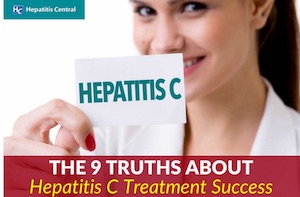
The 9 Truths About Hepatitis C Treatment Success
 As the medications for Hepatitis C continue to improve, greater numbers of people are relishing in their successful treatment outcomes. Despite finally being free of the Hepatitis C virus, most physicians refrain from telling their patients they are cured. The reason for avoiding this terminology is uncertainty regarding the implications of successful Hepatitis C treatment.
As the medications for Hepatitis C continue to improve, greater numbers of people are relishing in their successful treatment outcomes. Despite finally being free of the Hepatitis C virus, most physicians refrain from telling their patients they are cured. The reason for avoiding this terminology is uncertainty regarding the implications of successful Hepatitis C treatment.
Many Hepatitis C drug regimens now boast a 95 percent or higher success rate. Successful treatment is defined as achieving a sustained viral response (SVR). SVR is considered attained when Hepatitis C is not detectable in the blood for at least six months after the last treatment dose. The hesitancy about SVR being the same as a cure has to do with whether or not it is permanent. Some healthcare practitioners will use the word “cure” because SVR is as close as we can get to curing Hepatitis C. Meanwhile, others will use the word “remission” because of doubts as to the permanence of SVR. Neither is entirely accurate.
In an effort to clarify Hepatitis C treatment success facts and Hepatitis C treatment success unknowns, below is a list of what we know to be true:
- Studies report that once patients have achieved SVR, they have a 99.2 to 100 percent chance of remaining free of Hepatitis C. In other words, less than 1 percent of people who achieve SVR experience a return of Hepatitis C infection.
- If Hepatitis C does return after achieving SVR, there is a good chance it is due to re-exposure, and being infected again with the virus.
- Some studies suggest that there are two groups at higher risk of Hepatitis C returning after SVR: injection drug users or prisoners, and those co-infected with HIV.
- Different from several other diseases, having Hepatitis C once does not provide immunity from getting it again.
- Even with SVR, there will still be Hepatitis C antibodies. This does not mean you are still infected. If there is no detectable Hepatitis C virus in the blood, there is nothing to transmit to others. Antibodies are your immune system’s response to a pathogen and are not infectious.
- After achieving SVR, routine Hepatitis C screening is typically advised to make sure you remain free of the virus and to catch any reemergence right away should it occur. A quantitative Hepatitis C RNA test that detects viral load is appropriate, not a Hepatitis C antibody test.
- After achieving SVR, doctors are hesitant to give patients permission to drink alcohol. This is due to many complicating factors. For example, drinking alcohol is extremely dangerous for those with liver cirrhosis – even if Hepatitis C has been eradicated.
- After achieving SVR, liver health almost always improves. This includes improved liver histology, reduced risk of hepatocellular carcinoma, and improved overall survival.
- With adherence to lifestyle choices that promote liver health, both cirrhosis and fibrosis have shown the capability of reversing after achieving SVR.
Compared to most other infectious diseases, the treatment and eradication of Hepatitis C is still in its relative infancy. The medical community is continuously learning and evolving, working hard to eliminate this viral infection of the liver.
The nine truths listed above are based on what we know to be true. There are still several unknowns, and until those unknowns are clarified, most physicians abstain from calling SVR a cure.
There is one thing for certain, achieving SVR is the closest we have to Hepatitis C eradication – and the likelihood of SVR being permanent is very, very high.